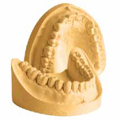Dental Impression

In Dentaltix you can find all materials needed to make the impression: adhesives, alginates, mixing cannulas, waxes, trays, detergents, impression paste, retractor paste, plates, single-phase polyether polyether, mixing tips, registration bite, silicones, casts...
Types of dental impressions:
1. Anatomical impressions: These are those that provide us with study models that do not require great precision of details. These models are used for: Total prosthesis, removable prosthesis, orthodontics, orthopedics.
The material used is Alginate
The instruments used: Standard plastic or metal buckets.
2. Functional Impressions: These are those that provide us with working models that require great precision of details.
The material used is mercapatan, zinquenol and silicones
The instruments used: individual acrylic cuvettes.
Dental impression is any impression taken on the teeth of a patient, performed in a dental clinic, and is achieved through certain non-toxic materials (called printing), such as alginate and silicone (condensation and Addition), contained in the different impression trays. Existing ones. The printing materials are prepared by mixing 2 components in such a way that a homogeneous paste is obtained which will harden to a completely solid state. There is therefore a short period of use. Once it gelates (in case of alginate) completely and is removed from the patient's mouth, we can say that the dental impression has been obtained.
From these dental impressions and through the process of emptying or positiveizing the same done in the dental laboratory by the dental technician, the models of plaster are obtained with which the prosthetic can work. Prints have a period of use, and should be cast as soon as possible.
The impressions must properly reproduce the patient's oral structures, especially the working areas, since if they have bubbles, distortions, drags, or have lost moisture, etc., the plaster model will be defective and so will be the subsequent work.
There are two techniques for taking the definitive impressions with silicone: The technique in two phases, and the technique simultaneously or in a single phase.
With the two-stage technique, the heavy silicone is first placed in the tray, inserted into the mouth and waiting for it to fragment and then fluid silicone is placed and waiting for it to set and the impression is emptied to send it to the laboratory. dental.
In the single session technique, the thick putty is placed in the bucket and at the same time At this time, the fluid silicone is placed on the teeth to be taken. The tray is placed in the mouth and waiting for it to set.
